School of Chemical and Materials Engineering (SCME) commenced its programs in 2006 and is currently offering undergraduate and postgraduate degree programs in the twin disciplines of Chemical Engineering and Materials Engineering. In line with the futuristic vision of NUST imparting quality education, maiden undergraduate programs in the fields of Chemical and Materials Engineering were launched in the year 2008. Presently, the school has 483 students of which more than 120 are pursuing degrees at the MS and PhD levels. Internationally recognized faculty, coupled with well-equipped state-of-the-art labs and learning resources, provide an ideal platform for the professional growth of all stakeholders.
An important element of the undergraduate program is the industrial design project aimed at strengthening understanding of engineering fundamentals and developing advanced engineering skills. The project also develops new outreach activities to inspire promising scholars to study at the University. At a higher level, these industrial design projects may contribute in making vital equipment inventions. Several significant industrial projects are at hand, involving private and strategic partners. This is envisioned to provide a framework for present and future collaboration between academia and the industry and to make an important contribution towards revitalizing the industry’s capability. It is due to this conviction that university-industry linkage is being forged at SCME in line with prevalent higher education policy.
Furthermore, to strength the relationship between industry and academia, several research projects are conducted on post graduate level. These projects are mainly from defense industry, fertilizer industry, oil and gas sector, cement industry and chemical industry. Previously, students have to face many issues in the analysis of their final products due to lack of analytical facilities present at the School level. However, within short period due to the support of NUST higher management and hard work of SCME faculty, SCME has established itself as one of the best institutes in the Pakistan with fully equipped latest characterization techniques.
At present moment, SCME is equipped with state-of-the art equipment to cater for the characterization and analysis of materials viz. A few of the equipment and their details are listed below:
1. X-Rays Diffraction (XRD)
X-ray Diffraction is a characterization technique based on constructive interference of monochromatic X-rays and a crystalline sample. Constructive interference when conditions satisfy Bragg’s Law (nλ = 2d sin θ). This relates the wavelength of electromagnetic radiation to the diffraction angle and the lattice spacing in a crystalline sample.
Specifications: STOE Germany S/N 65022, θ = 5o – 160o, Step Size = 0.004o, radiation = Cu K α
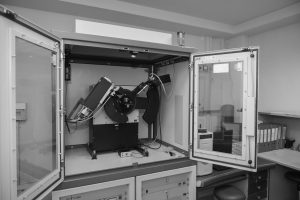
2. Scanning Electron Microscopy (SEM)
Scanning Electron Microscope (SEM) is used to study morphology of a material based on interaction of electron beam with atoms at various depths within sample. It produces images by scanning the surface with a beam of electrons. The mode of detection is secondary electrons emitted by atoms excited by the electron beam.
Specifications: JEOL Japan JSM-6490A, resolution = 3nm, magnification = 5x to 300000x, Secondary electron detector = E.T detector, Filament = Tungsten
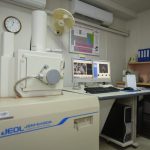
3. Raman Microscope and Analyzer
Raman microscopy is a non-destructive chemical analysis technique which provides detailed information about chemical structure, phase and polymorphy, crystallinity and molecular interactions. It is based upon the interaction of light with the chemical bonds within a material.
Specification: High Resolution TE Cooled Fiber Optic Raman System, 1064nm Fiber Optics, Laser = 532 nm, Power = 50 mW max, Range = 150 – 4000 cm-1, Resolution = 4.5 cm-1 at 614 nm, laser power control = 0 – 100 %.
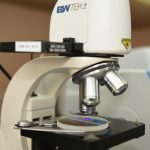
4. Fourier Transform Infrared Spectroscopy (FT-IR)
Fourier Transform Infrared Spectroscopy (FTIR) is an analytical technique which is used for the qualitative analysis of compounds. FTIR is used to determine the type of chemical bonds present in a sample by producing the infrared absorption spectrum that is like a molecular fingerprint of sample. It can also be used to identify functional groups and molecular structure of a material.
Specifications: Perkin Elmer USA Spectrum 10D, Frequency Range = 350 – 7800 cm-1, KBr Disc, Resolution = 0.5 cm, Mode = Absorption / Transmittance, Operating Temperature = Room Temperature, Samples = Liquid and solids.
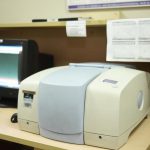
5. High Performance Liquid Chromatography (HPLC)
High Performance Liquid Chromatography (HPLC) is an analytical chromatographic technique which is used to separate, identify and quantify the components present in a mixture. Liquid chromatography is a well-established technique for the separation of substances. HPLC can be used for both qualitative analysis as well as quantitative analysis.
Specifications: Perkin Elmer USA Series 20D HPLC, Maximum operating pressure = 6200 psi, Flow rate = 0.1 – 10 ml/min, mobile phase = methanol, water, acetonitrile, elution mode = gradient and isocratic, operating temperature = room temperature, samples = liquid and solids in solution phase.
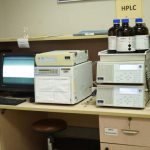
6. Gas Chromatograph Mass spectrometer (GC-MS)
Gas Chromatography Mass Spectrometry (GCMS) is a technique used for the qualitative and quantitative analysis of organic volatile and semi-volatile compounds. It is a hyphenated analytical technique that combines the separation properties of gas-liquid chromatography with the detection feature of mass spectrometry.
Specification: Perkin Elmer USA, Clarus 50D, GC injector temperature = maximum 450oC, oven temperature programmer = 3 ramp, detector 1 = mass spectrometer (MS), detector 2 = Flame ionization detector (FID), Source = electron ionization, mass range = 1.0 to 1000 amu, samples = liquid or solids in the form of dilute solutions.
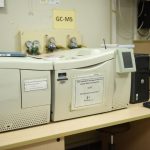
7. Differential Scanning Calorimetry (DSC)
Differential Scanning Calorimetry is a fundamental tool in thermal analysis. Differential scanning calorimetry (DSC) is the most frequently used thermal analysis technique alongside TGA, TMA and DMA. DSC is used to measure enthalpy changes due to changes in the physical and chemical properties of a material as a function of temperature or time.
Specification: Perkin Elmer USA DSC6000, maximum temperature = 450 oC, minimum temperature = -180 oC, scanning rate = 0.1 oC / min to 100 oC/min, operating atmosphere = nitrogen.
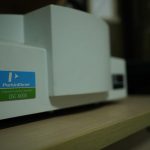
8. Ultraviolet-Visible Spectroscopy (UV-Vis)
Ultraviolet Visible Spectroscopy (UV-Vis) refers to absorption spectroscopy or reflectance spectroscopy in part of the ultraviolet and the adjacent visible spectral regions. It is an analytical technique that is used to measure the attenuation of a light beam after it passes through sample. This technique can be used both for the qualitative as well as quantitative analysis of compounds. The analyte is present is the form of a dilute solution.
Specification: Analytik Jena Germany, SPECORD 200 Plus, wavelength = 190 – 1100 nm, cuvette material = quartz, lamp = halogen deuterium, minimum wavelength = 190 nm, maximum wavelength = 1100 nm, bandwidth = 1.4 nm, scanning = dual beam, operating temperature = room temperature, samples = liquids/solids in solution phase.
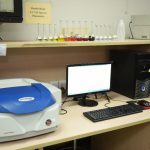
9. BET Surface Area
BET (Brunauer, Emmett and Teller) is used to measure the specific surface area of a sample including the pore size distribution. This information is used to predict the dissolution rate, as this rate is proportional to the specific surface area. Thus, the surface area can be used to predict properties of material.
Specification: Micrometrics, Gemini VII2390t, Surface Area range = 0.1m2 or 0.01m2g, Pore volume = 0.000004 cm3 g-1
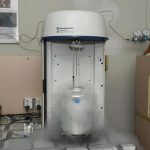
10. Elemental Analyzer (EA)
Elemental Analyzer is used for determination of carbon, hydrogen, nitrogen, sulphur and oxygen content in organic and other types of materials. Elemental analysis is a process where by a sample of some material (e.g., soil, waste or drinking water, bodily fluids, minerals, chemical compounds) is analyzed for its elemental and sometimes isotopic composition.
Specifications: NC Technologies Italy ECS 8020, CHNS-O, Furnace temperature: max 1100 oC, Accuracy < 0.2 %, Precision < 0.1 %, Sampler = Autosampler, sample size = 500 mg, sample type = liquid, solid
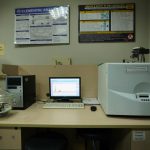
11. Universal testing Machine
Mechanical testing includes tensile testing, bend testing, compression testing, peel testing and many more. The “universal” part of the name reflects that it can perform many standard tensile and compression tests on materials, components, and structures. Types of materials we can test on this machine include metals, polymers and membranes.
Specification: Shimadzu Japan AGX-Plus, max force = 50KN, strain rate = 0.0001 – 1000 (mm/min), max thickness = 7 mm (flat sample), max width = 24 mm (flat sample) and max diameter = 4-9 mm (round sample)
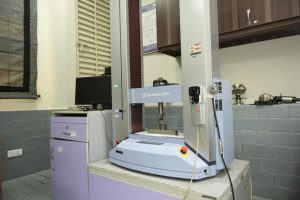
12. Impact Testing Machine
Impact Testing Machines evaluate an object’s capacity to withstand high-rate loading and it is commonly used to determine the service life of a part or material. Impact resistance can be among the most challenging qualities to measure. Impact tests are used in studying the toughness of material. A material’s toughness is a factor of its ability to absorb energy during plastic deformation.
Specifications: Brooks England IT3u, Diamond indentor pyaramid shape, minimum load = 10 g, maximum load = 100 g, resolution = 0.1 µm, measuring range = 200 µm, hardness value = 5 digit, SDiagonal length = 4digit (D1, D2), maximum specimen height = 85 mm (2.55o), operating temperature range = 10 to 38 oC (50 to 100 F)
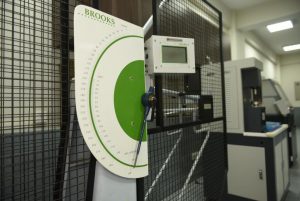
SCME also has a strong tradition of holding workshops and seminars on contemporary topics of interest in the area of characterization and analytical techniques for academia and industry professionals. One of the key workshop organized by SCME is of one week i.e. workshop on “Advanced Characterization Techniques for Energetic Materials Engineering Professionals” dated February 15-19th, 2021 under the banner of RIC NUST. The purpose of this workshop was to familiarize the participants with the state-of-the-art developments in characterization techniques such as SEM, FT-IR, HPLC, VOD meter, TG/DTA, GC-MS and UV-Visible spectroscopy. The workshop would provide a platform for interactive discussion between scientists and researchers and enable them to share their knowledge. The workshop includes lectures and lab demonstration.
Keeping in view of above, SCME decided to showcase its facilities for academia and industry. An extensive exercise was conducted to finalize SCME Lab facilities brochure. This lab brochure is an effort to outreach the relevant industry and defense/ strategic organizations, so that strong linkages between industry and academia can be established. The soft version of this lab brochure is available at SCME website link https://scme.nust.edu.pk/in-the-spotlight/scme-lab-facilities- portfolio. It is our privilege to lead and share the R&D facilities available at SCME.
The author is HoD Research at School of Chemical and Materials Engineering (SCME), Department of Chemical Engineering, National University of Sciences and Technology (NUST) and can be reached at [email protected]





